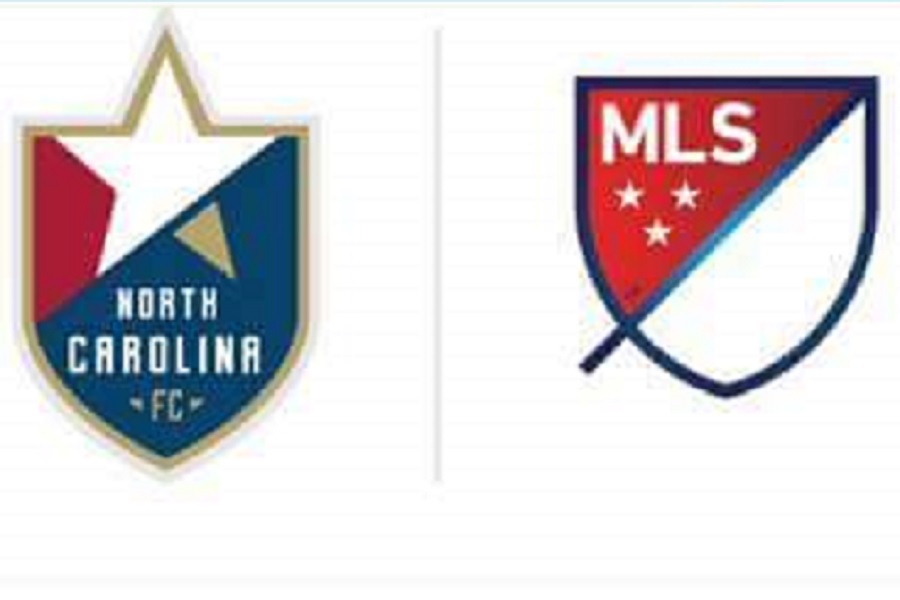The most frequent question about the professional soccer team that plays in Cary, NC, is famously: “what the hell is a RailHawk?” It’s a good question, because there is in fact no such thing as a RailHawk. But at the very least, the name is unique and local. After ten years of use, it is also what passes as historic in the compressed and erratic history of US soccer.
But in two days, fans in the triangle and across the country will no longer be confused about the name of North Carolina’s best professional soccer team. As shared by Neil Morris, the team will announce a rebrand on Tuesday that does away with the RailHawks name and colors in favor of the name North Carolina FC, the colors of the North Carolina flag, a star, and the shape of the MLS logo. This is the brand identity that owner Steve Malik is hoping will get his team into MLS.
.@RailHawksFC big news seeping out. Here's their apparent new name – North Carolina FC – logo, with announcement of MLS intentions. pic.twitter.com/mQ5u4RMka0
— Neil Morris (@ByNeilMorris) December 2, 2016
We don’t need to spend a great deal of time analyzing the new crest’s elements to say that it’s a very safe choice. Assuming that the leaked image is indeed the actual crest and not a placeholder (because it could easily be a placeholder and that’s not a good thing) the North Carolina FC identity represents the latest in a string of dull and uninspired logos that have swept the US soccer scene. A natural outgrowth of the trend towards European-style names, the wave of dull identities is not the biggest issue in the world, but it sure is annoying.
https://twitter.com/bornwithatail_/status/804702675518574592
You might suggest that this is hypocritical from a Minnesota website who fought to keep its team named something Europhillic and boring. But the Minnesota United FC identity is an illustrative example. Eyes rolled when the “United” name was announced. But jaws dropped when people saw the crest. The key feature of the entire team’s identity is the crest element of the Loon, which immediately gave fans something to latch onto. Before the rebranding event had ended, the team had a staid, respectable soccer name, and a nickname around which to begin to build an organic culture.
This is how they do it in most other parts of the world. Our naming conventions are generally borrowed from England and Scotland, where teams have an official name and a ubiquitous nickname. Often, though not always, that nickname is a central feature of the club crest. This isn’t the only way to do it, but American soccer teams don’t seem to be giving fans any help in establishing common symbols to rally around.
Take Minnesota’s MLS expansion-mates, Atlanta United FC. After a long public brainstorming process that included intriguing names playing off Atlanta’s history as a railroad hub, its postbellum rebirth from the ashes, and other wild cards like “Black Harts”, the team went the unimaginative route with “United.” But unlike Minnesota’s effort years earlier, Atlanta declined to do anything interesting with their badge. What do we call Atlanta? The stripes? The A’s? The red and blacks? There’s not a lot to work with, and no evidence that fans have made any headway.
Joining MLS in 2018 are LAFC, who have insisted upon that soporific name since the very start. They’ve since added a very slick new crest, but the central problem remains. What to call this team? The wings? The angels (recipe for a lawsuit)? The Art Decos? Do they inherit “the goats” from the ghost of Chivas USA?
NYCFC similarly started life with a beautiful but completely unhelpful crest. It didn’t happen immediately, but enough fans have started to call the team “the Pigeons” to give me some hope of that fun, local, and interesting nickname sticking around.
You can go on an on with this stuff. Louisville City FC. St. Louis FC. FC Cincinnati. San Antonio FC. Puerto Rico FC. Nashville FC. Dull, dull, and dull.
Only a few clubs have gotten it right. The shining example among them is the Sacramento Republic, which managed to find an official name that was unique, local, and still Euro-sounding. Slap the state flag’s bear on the crest, and you’ve got the makings of a great club identity in the capital of California. Orlando City SC also found success, despite Orlando really being more accurately described as a large suburb. But the addition of lions to their USL crest and the prominent sun/lion on their MLS crest have reinforced the team’s nickname and identity.
Not every team needs to be the Rochester River Dogz or the Carolina RailHawks. There is a middle ground between a club looking minor league and looking joyless. One great way to do that is to create an identity that works formally and informally. Teams in the US have evidently lost that art, and that’s a shame.

Leave a Reply